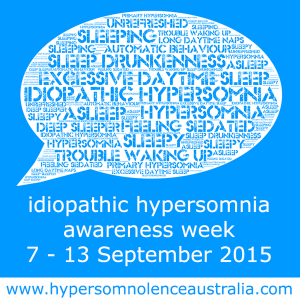Welcome to a guest post from Michelle Chadwick of Hypersomnolence Australia telling us about this weeks Idiopathic Hypersomnia Awareness Week. She says:-
“Hypersomnolence Australia launched the first international Idiopathic Hypersomnia Awareness Week in 2013 with a radio interview discussing the importance of community awareness. This year we will be focusing on education with a written tribute tothe renowned Czech neurologist Bedrich Roth who was responsible for identifying and naming Idiopathic Hypersomnia.
This year marks the 35th anniversary of Roth’s classic 1980 text Narcolepsy and Hypersomnia (S. Karger; NY, NY). In our tribute “Bedrich Roth, His Life’s Work and the 35th Anniversary of the Book “Narcolepsy and Hypersomnia” we document Roth’s significant contribution to the pioneering pathophysiology and epidemiological study of narcolepsy and Hypersomnia. Narcolepsy and Hypersomnia contributed to the English literature for the first time the largest most meticulously followed series of all the then known neurological sleep disorders.
We have been discussing Roth’s life work, his book and the current issues with regards to idiopathic hypersomnia with sleep researchers and clinicians throughout the world including Professors Roger Broughton, Michel Billiard, Karel Sonka, Sona Nevsimalova, Isabelle Arnulf and David Rye.
It is clear that:
– Idiopathic hypersomnia is often misdiagnosed and misinterpreted. Education of physicians and sleep specialists is imperative.
– Current testing methods (MSLT) and diagnostic criteria is inappropriate. There is an urgent need for biological markers.
– ICSD3 combined idiopathic hypersomnia is not supported by data. It is a step back in the definition of idiopathic hypersomnia as it potentially encompasses a variety of different diseases.
– The exact prevalence is unknown but is thought by many to be as high as Narcolepsy.
– Further research is required on the genetic aspects of the disease.
– Idiopathic hypersomnia (IH) is a “true” and disabling neurological sleep disorder. People with IH are not lazy, sleepiness is a symptom of the disease and is usually not relived by sleep or medications.
– There are no approved medications specifically for Idiopathic Hypersomnia. Medications used to treat Narcolepsy including stimulants and wake-promoting medications are prescribed to counter daytime sleepiness however there are no medications that assist with the extreme difficulty waking up or the sleep drunkenness. Stimulant and wake promoting medications can be helpful to relieve sleepiness for some patients however for many they are not effective or appropriate. New and appropriate therapies are needed.
– The impaired cognitive ability, the excessive sleep, and continuous feeling of never being fully awake profoundly affects work, education, and quality of life and leaves sufferers at risk of potentially life-threatening accidents.
What can you do to help raise awareness?
- Like our Facebook page and join the Facebook awareness week event
- Follow us on Twitter tweet and retweet us @Hyper_Sleep
- Use the hashtags #IHAW2015 and #HAIHope to tell us what you hope for.
- Share our posters or make your own and share them with us!
- Change your profile picture and cover photo
- Share your Patient Perspective send us an email to hypersomnolenceaustralia@gmail.com
- Share the Idiopathic Hypersomnia Fact Sheet electronically or download and print out a copy for your health professionals
- Make a tax deductible donation
- Share your ideas with us. If you have an idea for raising awareness, fundraising or have a talent you think could help? Then send us an email hypersomnolenceaustralia@gmail.com
And don’t forget to share our great “you know you have idiopathic hypersomnia when…” memes!! You can find them here“

